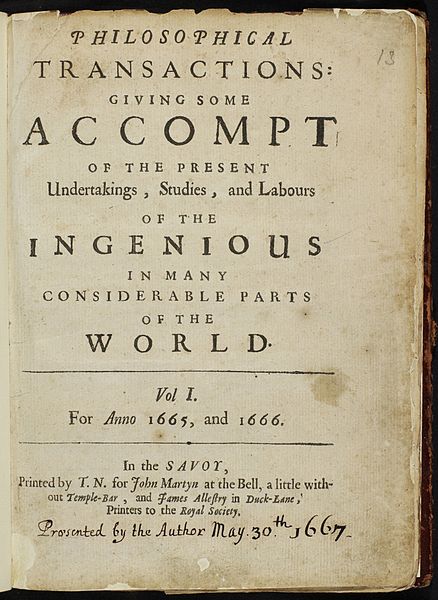Philosophiae Naturalis Principia Mathematica (1687)

Authored by Isaac Newton, this groundbreaking journal revolutionized science with its introduction of the laws of motion and universal gravitation. Written in Latin, it set the foundation for classical mechanics, influencing physics and astronomy for centuries. Newton’s rigorous mathematical approach provided a systematic framework for understanding natural phenomena. The journal also explored fluid dynamics, planetary motion, and tidal behavior, showcasing the breadth of Newton’s intellect. Its publication elevated the role of mathematics in scientific inquiry, shifting the era toward empiricism. Despite initial resistance, its profound ideas quickly gained acceptance in Europe. Today, it remains a cornerstone of scientific literature.
Philosophical Transactions of the Royal Society (1665)

As the world’s first scientific journal, this publication marked the beginning of formal academic peer review. Launched by Henry Oldenburg, it provided a platform for researchers to share findings openly and collaboratively. The journal showcased early works in medicine, chemistry, and physics, fostering interdisciplinary communication. Over the centuries, its volumes included pivotal discoveries such as the identification of microorganisms by Antony van Leeuwenhoek. It also published Darwin’s preliminary theories on evolution. The journal’s emphasis on empirical evidence set a precedent for future publications. Today, it continues as one of the longest-running scientific journals.
The Origin of Species (1859)

While technically a book, Charles Darwin’s seminal work began as a compilation of journal observations from his voyage on the HMS Beagle. It introduced the theory of natural selection, reshaping biology and anthropology forever. Darwin meticulously detailed evidence of species adaptation across generations. His observations challenged established views on creationism and sparked widespread debate. The work’s reliance on extensive field notes gave it a journal-like precision. Readers were captivated by Darwin’s logical explanations of evolution. This foundational text remains critical for understanding biodiversity and genetics.
The Lancet (1823)

Founded by Thomas Wakley, this journal revolutionized medical publishing with its commitment to public health. It published critical advancements such as the use of anesthesia and germ theory. The Lancet was one of the first journals to advocate for accessible medical knowledge. Wakley’s commitment to addressing malpractice also helped improve healthcare standards. Over time, it became a platform for exposing public health crises and introducing novel treatments. Modern editions tackle global challenges like pandemics and climate health. The Lancet’s rich legacy endures as a pillar of medical research.
Nature (1869)

Nature emerged as a multidisciplinary platform for some of the most groundbreaking discoveries in science. Early publications included seminal work in evolutionary biology and physical sciences. Over the decades, Nature introduced discoveries like DNA’s double helix and breakthroughs in particle physics. Its concise yet impactful articles catered to a broad scientific audience. The journal’s ability to present cutting-edge research propelled it to global renown. Today, it ranks among the most cited and prestigious journals in academia. Its influence extends across disciplines, inspiring future generations of researchers.
Science (1880)

Founded by Thomas Edison and later acquired by the American Association for the Advancement of Science, Science united various fields under one publication. It championed interdisciplinary research, including early breakthroughs in neuroscience, genetics, and climate science. Throughout its history, it has published pivotal papers such as Watson and Crick’s DNA structure. Its editorial rigor ensures the credibility of every article. The journal also serves as a critical medium for public policy recommendations rooted in scientific evidence. Readers value its global reach and wide-ranging topics. It remains a top-tier scientific publication to this day.
Journal of the American Medical Association (JAMA) (1883)

JAMA brought rigorous peer review to the medical community, raising the standard for clinical research. Early editions tackled public health challenges like sanitation and vaccination. The journal later became instrumental in publishing landmark studies on heart disease, cancer, and mental health. Its wide readership ensured that findings influenced both physicians and policymakers. JAMA’s commitment to ethical guidelines and evidence-based medicine set benchmarks for others to follow. The journal expanded globally to address emerging health crises. It continues to lead in medical publishing, shaping healthcare practice worldwide.
Bulletin of the Atomic Scientists (1945)

Founded by scientists involved in the Manhattan Project, this journal highlighted the ethical implications of nuclear technology. Its most iconic feature, the Doomsday Clock, symbolized the urgency of global threats like nuclear war and climate change. The journal became a trusted source for insights on arms control and energy policy. It educated policymakers and the public on the far-reaching consequences of scientific advancements. Articles emphasized the balance between innovation and responsibility, influencing international relations during the Cold War. Its commitment to science communication made it a unique and essential publication. Today, it continues to advocate for science-driven solutions to global challenges.
The BMJ (British Medical Journal) (1840)

One of the oldest medical journals, BMJ introduced many pioneering concepts in clinical practice and public health. Early publications focused on hygiene, infectious diseases, and healthcare reform. Its articles promoted evidence-based medicine, challenging outdated practices. The BMJ also became a vocal advocate for healthcare accessibility and ethical research standards. Landmark studies on diseases such as tuberculosis and diabetes were widely disseminated through this platform. Its role in educating medical professionals extended globally, shaping modern healthcare. Today, BMJ continues to publish influential research that drives improvements in patient care.
American Journal of Mathematics (1878)

This journal bridged theoretical and applied mathematics, fostering innovation in both fields. Early publications included advancements in algebra, calculus, and geometry. It provided a platform for pioneering work in number theory and mathematical physics. The journal attracted contributions from prominent mathematicians such as Henri Poincaré. Its role in connecting abstract theory with practical applications influenced technological progress. Articles often introduced concepts that became essential for engineering and computer science. Today, the American Journal of Mathematics remains a respected venue for cutting-edge mathematical research.
This article originally appeared on Rarest.org.
More From Rarest.Org
The ocean is home to some of the most fascinating masters of disguise, where survival often depends on the ability to blend in. From octopuses that can change both color and texture to mimic their surroundings to tiny sea slugs that look like leaves drifting through the water, camouflage is a powerful tool for marine life. Read more.
Tortoises are some of the longest-living creatures on Earth, with lifespans that often surpass a century. Their slow pace, sturdy shells, and tranquil lifestyles contribute to their incredible longevity, allowing them to witness generations of change around them. Read more.
Collecting rare perfume bottles is more than just a passion for fragrance lovers; it’s a way to preserve the artistry, history, and elegance that each bottle embodies. From limited editions adorned with crystals to vintage pieces crafted by iconic glassmakers, these bottles hold timeless beauty and incredible craftsmanship that elevate them beyond simple containers for fragrance. Read more.



